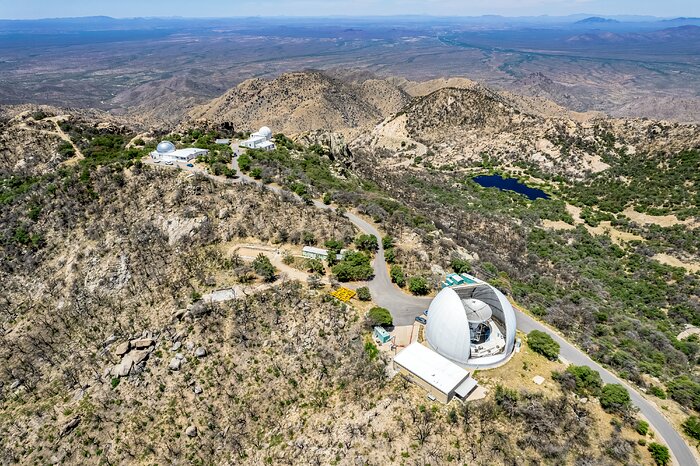Observando las 24 horas
Esta vista aérea de dron muestra la cresta suroeste del Observatorio Nacional Kitt Peak (KPNO), un Programa de NOIRLab de la Fundación Nacional de Ciencias (NSF) de EE.UU., recuperándose del incendio Contreras que alcanzó los terrenos del observatorio en junio de 2022. A lo lejos se ven los telescopios reflectores Hiltner de 2,4 metros (izquierda) y el McGraw Hill de 1,3 metros (derecha) que constituyen el Observatorio MDM que es propiedad y está operado por un consorcio de universidades que incluye a la Universidad de Michigan, Dartmouth, Universidad de Ohio, Universidad Estatal de Ohio y Universidad de Columbia. En la esquina inferior derecha, se ve en funcionamiento el Telescopio de 12 metros de la Universidad de Arizona, que tiene un radiotelescopio dentro de su cúpula. Los operadores de telescopios ópticos deben esperar la noche para realizar sus observaciones, ya que durante el día la luz de los objetos lejanos queda eclipsada por el Sol. Sin embargo, la emisión del Sol en radiofrecuencias es relativamente débil y, por tanto, no interfiere con las radiofrecuencias que reciben los telescopios, lo que permite realizar observaciones las 24 horas del día. Además, la nubosidad de nuestra atmósfera no bloquea las ondas de radio, por lo que las observaciones pueden realizarse incluso con cielos nublados.
Créditos:KPNO/NOIRLab/NSF/AURA/P. Marenfeld
About the Image
| Id: | iotw2417a |
| Idioma: | es |
| Tipo: | Photographic |
| Release date: | 24 de Abril de 2024 a las 12:00 |
| Size: | 5464 x 3640 px |
Sobre el Objeto
| Nombre: | McGraw-Hill 1.3-meter Telescope, The Hiltner 2.4-meter Telescope, UArizona 12-meter Telescope |
| Categoría: | Kitt Peak National Observatory |
